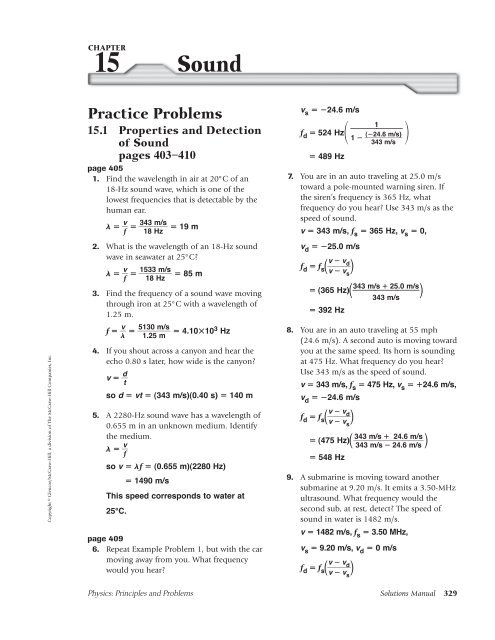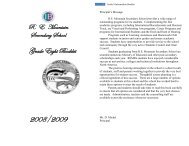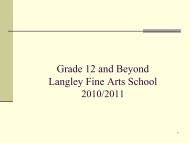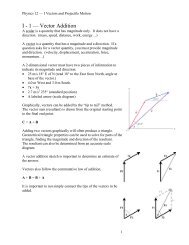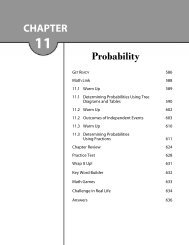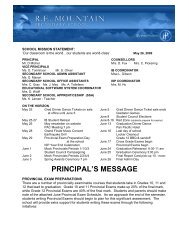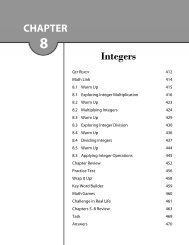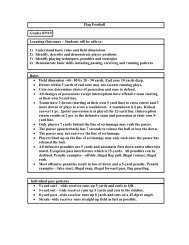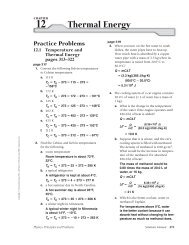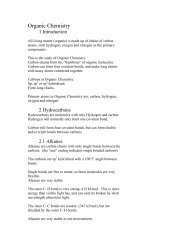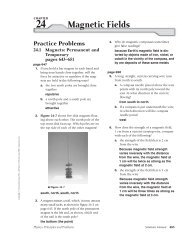Physics Solutions Manual
Physics Solutions Manual
Physics Solutions Manual
Create successful ePaper yourself
Turn your PDF publications into a flip-book with our unique Google optimized e-Paper software.
Copyright © Glencoe/McGraw-Hill, a division of The McGraw-Hill Companies, Inc.<br />
CHAPTER<br />
15 Sound<br />
Practice Problems<br />
15.1 Properties and Detection<br />
of Sound<br />
pages 403–410<br />
page 405<br />
1. Find the wavelength in air at 20°C of an<br />
18-Hz sound wave, which is one of the<br />
lowest frequencies that is detectable by the<br />
human ear.<br />
v 43<br />
m/s<br />
3 19 m<br />
f 18<br />
Hz<br />
2. What is the wavelength of an 18-Hz sound<br />
wave in seawater at 25°C?<br />
v 33<br />
m/s<br />
15 85 m<br />
f 18<br />
Hz<br />
3. Find the frequency of a sound wave moving<br />
through iron at 25°C with a wavelength of<br />
1.25 m.<br />
v 5130<br />
m/s<br />
f 4.1010<br />
1.25<br />
m<br />
3 Hz<br />
4. If you shout across a canyon and hear the<br />
echo 0.80 s later, how wide is the canyon?<br />
v d<br />
t <br />
so d vt (343 m/s)(0.40 s) 140 m<br />
5. A 2280-Hz sound wave has a wavelength of<br />
0.655 m in an unknown medium. Identify<br />
the medium.<br />
v<br />
f <br />
so v f (0.655 m)(2280 Hz)<br />
1490 m/s<br />
This speed corresponds to water at<br />
25°C.<br />
page 409<br />
6. Repeat Example Problem 1, but with the car<br />
moving away from you. What frequency<br />
would you hear?<br />
v s 24.6 m/s<br />
1<br />
<br />
fd 524 Hz 1 <br />
(24.6<br />
m/s)<br />
<br />
343<br />
m/s<br />
489 Hz<br />
7. You are in an auto traveling at 25.0 m/s<br />
toward a pole-mounted warning siren. If<br />
the siren’s frequency is 365 Hz, what<br />
frequency do you hear? Use 343 m/s as the<br />
speed of sound.<br />
v 343 m/s, f s 365 Hz, v s 0,<br />
v d 25.0 m/s<br />
fd fsv v<br />
v v<br />
<strong>Physics</strong>: Principles and Problems <strong>Solutions</strong> <strong>Manual</strong> 329<br />
d <br />
s<br />
343 m/s 25.0 m/s<br />
(365 Hz) 343 m/s<br />
392 Hz<br />
8. You are in an auto traveling at 55 mph<br />
(24.6 m/s). A second auto is moving toward<br />
you at the same speed. Its horn is sounding<br />
at 475 Hz. What frequency do you hear?<br />
Use 343 m/s as the speed of sound.<br />
v 343 m/s, f s 475 Hz, v s 24.6 m/s,<br />
v d 24.6 m/s<br />
d <br />
s<br />
fd fsv v<br />
v v<br />
343 m/s 24.6 m/s<br />
(475 Hz) 343 m/s 24.6 m/s <br />
548 Hz<br />
9. A submarine is moving toward another<br />
submarine at 9.20 m/s. It emits a 3.50-MHz<br />
ultrasound. What frequency would the<br />
second sub, at rest, detect? The speed of<br />
sound in water is 1482 m/s.<br />
v 1482 m/s, f s 3.50 MHz,<br />
v s 9.20 m/s, v d 0 m/s<br />
d <br />
s<br />
fd fsv v<br />
v v
Chapter 15 continued<br />
1482 m/s<br />
(3.50 MHz) 1482 m/s 9.20 m/s<br />
3.52 MHz<br />
10. A sound source plays middle C (262 Hz).<br />
How fast would the source have to go to<br />
raise the pitch to C sharp (271 Hz)? Use<br />
343 m/s as the speed of sound.<br />
v 343 m/s, f s 262 Hz, f d 271 Hz,<br />
v d 0 m/s, v s is unknown<br />
d <br />
s<br />
fd fsv v<br />
v v<br />
Solve this equation for v s .<br />
fs<br />
vs v (v vd )<br />
f<br />
d<br />
343 m/s 2 62<br />
Hz<br />
(343 m/s 0 m/s)<br />
271<br />
Hz<br />
11.4 m/s<br />
Section Review<br />
15.1 Properties and Detection<br />
of Sound<br />
pages 403–410<br />
page 410<br />
11. Graph The eardrum moves back and forth<br />
in response to the pressure variations of a<br />
sound wave. Sketch a graph of the displacement<br />
of the eardrum versus time for two<br />
cycles of a 1.0-kHz tone and for two cycles<br />
of a 2.0-kHz tone.<br />
Displacement<br />
Time (ms)<br />
0.5 1.0 1.5 2.0<br />
12. Effect of Medium List two sound characteristics<br />
that are affected by the medium<br />
through which the sound passes and two<br />
characteristics that are not affected.<br />
affected: speed and wavelength;<br />
unaffected: period and frequency<br />
1.0 kHz<br />
2.0 kHz<br />
13. Sound Properties What physical characteristic<br />
of a sound wave should be changed<br />
to change the pitch of the sound? To<br />
change the loudness?<br />
frequency; amplitude<br />
14. Decibel Scale How much greater is the<br />
sound pressure level of a typical rock band’s<br />
music (110 dB) than a normal conversation<br />
(50 dB)?<br />
The sound pressure level increases by<br />
a factor of 10 for every 20-dB increase<br />
in sound level. Therefore, 60 dB corresponds<br />
to a 1000-fold increase in SPL.<br />
15. Early Detection In the nineteenth century,<br />
people put their ears to a railroad track to<br />
get an early warning of an approaching<br />
train. Why did this work?<br />
The velocity of sound is greater in<br />
solids than in gases. Therefore, sound<br />
travels faster in steel rails than in air,<br />
and the rails help focus the sound so it<br />
does not die out as quickly as in air.<br />
16. Bats A bat emits short pulses of highfrequency<br />
sound and detects the echoes.<br />
a. In what way would the echoes from<br />
large and small insects compare if they<br />
were the same distance from the bat?<br />
They would differ in intensity. Larger<br />
insects would reflect more of the<br />
sound energy back to the bat.<br />
b. In what way would the echo from an<br />
insect flying toward the bat differ from<br />
that of an insect flying away from the<br />
bat?<br />
An insect flying toward the bat<br />
would return an echo of higher frequency<br />
(Doppler shift). An insect flying<br />
away from the bat would return<br />
an echo of lower frequency.<br />
17. Critical Thinking Can a trooper using a<br />
radar detector at the side of the road<br />
determine the speed of a car at the instant<br />
the car passes the trooper? Explain.<br />
No. The car must be approaching or<br />
330 <strong>Solutions</strong> <strong>Manual</strong> <strong>Physics</strong>: Principles and Problems<br />
Copyright © Glencoe/McGraw-Hill, a division of The McGraw-Hill Companies, Inc.
Copyright © Glencoe/McGraw-Hill, a division of The McGraw-Hill Companies, Inc.<br />
Chapter 15 continued<br />
receding from the detector for the<br />
Doppler effect to be observed.<br />
Transverse motion produces no<br />
Doppler effect.<br />
Practice Problems<br />
15.2 The <strong>Physics</strong> of Music<br />
pages 411–419<br />
page 416<br />
18. A 440-Hz tuning fork is held above a closed<br />
pipe. Find the spacing between the resonances<br />
when the air temperature is 20°C.<br />
Resonance spacing <br />
so using v<br />
2 f <br />
the resonance spacing is<br />
<br />
2 v 343<br />
m/s<br />
0.39 m<br />
2f<br />
(2)(<br />
440<br />
Hz)<br />
19. A 440-Hz tuning fork is used with a<br />
resonating column to determine the<br />
velocity of sound in helium gas. If the<br />
spacings between resonances are 110 cm,<br />
what is the velocity of sound in helium gas?<br />
Resonance spacing <br />
1.1 m<br />
2<br />
so 2.2 m<br />
v f (2.2 m)(440 Hz) 970 m/s<br />
20. The frequency of a tuning fork is unknown.<br />
A student uses an air column at 27°C and<br />
finds resonances spaced by 20.2 cm. What<br />
is the frequency of the tuning fork? Use the<br />
speed calculated in Example Problem 2 for<br />
the speed of sound in air at 27°C.<br />
v 347 m/s at 27°C<br />
Resonance spacing gives <br />
0.202 m,<br />
2<br />
or 0.404 m<br />
v 347<br />
m/s<br />
f 859 Hz<br />
0.404<br />
m<br />
21. A bugle can be thought of as an open pipe.<br />
If a bugle were straightened out, it would be<br />
2.65-m long.<br />
a. If the speed of sound is 343 m/s, find<br />
the lowest frequency that is resonant for<br />
a bugle (ignoring end corrections).<br />
1 2L (2)(2.65 m) 5.30 m<br />
The lowest frequency is<br />
v<br />
f1 <br />
1<br />
343<br />
m/s<br />
64.7 Hz<br />
5.30<br />
m<br />
b. Find the next two resonant frequencies<br />
for the bugle.<br />
v v 343<br />
m/s<br />
f2 129 Hz<br />
2<br />
L 2.65<br />
m<br />
v 3v<br />
f3 <br />
3<br />
2L<br />
( 3)<br />
( 343<br />
m/s)<br />
194 Hz<br />
( 2)<br />
( 2.65<br />
m)<br />
Section Review<br />
15.2 The <strong>Physics</strong> of Music<br />
pages 411–419<br />
page 419<br />
22. Origins of Sound What is the vibrating<br />
object that produces sounds in each of the<br />
following?<br />
a. a human voice<br />
vocal cords<br />
b. a clarinet<br />
a reed<br />
c. a tuba<br />
the player’s lips<br />
d. a violin<br />
a string<br />
23. Resonance in Air Columns Why is the<br />
tube from which a tuba is made much<br />
longer than that of a cornet?<br />
The longer the tube, the lower the<br />
resonant frequency it will produce.<br />
24. Resonance in Open Tubes How must the<br />
length of an open tube compare to the<br />
wavelength of the sound to produce the<br />
strongest resonance?<br />
The length of the tube should be<br />
one-half the wavelength.<br />
25. Resonance on Strings A violin sounds a<br />
note of F sharp, with a pitch of 370 Hz.<br />
What are the frequencies of the next three<br />
harmonics produced with this note?<br />
A string’s harmonics are whole number<br />
multiples of the fundamental, so the frequencies<br />
are:<br />
<strong>Physics</strong>: Principles and Problems <strong>Solutions</strong> <strong>Manual</strong> 331
Chapter 15 continued<br />
f 2 2f 1 (2)(370 Hz) 740 Hz<br />
f 3 3f 1 (3)(370 Hz) 1110 Hz<br />
1100 Hz<br />
f 4 4f 1 (4)(370 Hz) 1480 Hz<br />
1500 Hz<br />
26. Resonance in Closed Pipes One closed<br />
organ pipe has a length of 2.40 m.<br />
a. What is the frequency of the note<br />
played by this pipe?<br />
4L (4)(2.40 m) 9.60 m<br />
v<br />
f <br />
v 343<br />
m/s<br />
f 35.7 Hz<br />
9.60<br />
m<br />
b. When a second pipe is played at the<br />
same time, a 1.40-Hz beat note is heard.<br />
By how much is the second pipe too<br />
long?<br />
f 35.7 Hz 1.40 Hz 34.3 Hz<br />
v 43<br />
m/<br />
s<br />
3 10.0 m<br />
f 34.3<br />
Hz<br />
4L<br />
L 0m<br />
10. 2.50 m<br />
4 4<br />
The difference in lengths is<br />
2.50 m 2.40 m 0.10 m<br />
27. Timbre Why do various instruments sound<br />
different even when they play the same note?<br />
Each instrument produces its own set<br />
of fundamental and harmonic frequencies,<br />
so they have different timbres.<br />
28. Beats A tuning fork produces three beats<br />
per second with a second, 392-Hz tuning<br />
fork. What is the frequency of the first<br />
tuning fork?<br />
It is either 389 Hz or 395 Hz. You can’t<br />
tell which without more information.<br />
29. Critical Thinking Strike a tuning fork with<br />
a rubber hammer and hold it at arm’s<br />
length. Then press its handle against a desk,<br />
a door, a filing cabinet, and other objects.<br />
What do you hear? Why?<br />
The tuning fork’s sound is amplified<br />
greatly when it is pressed against other<br />
objects because they resonate like a<br />
sounding board. They sound different<br />
because they resonate with different<br />
harmonics; therefore, they have different<br />
timbres.<br />
Chapter Assessment<br />
Concept Mapping<br />
page 424<br />
30. Complete the concept map below using the<br />
following terms: amplitude, perception, pitch,<br />
speed.<br />
speed<br />
properties<br />
frequency<br />
Sound<br />
pitch<br />
amplitude<br />
perception<br />
Mastering Concepts<br />
page 424<br />
31. What are the physical characteristics of<br />
sound waves? (15.1)<br />
Sound waves can be described by<br />
frequency, wavelength, amplitude,<br />
and speed.<br />
loudness<br />
32. When timing the 100-m run, officials at the<br />
finish line are instructed to start their stopwatches<br />
at the sight of smoke from the<br />
starter’s pistol and not at the sound of its<br />
firing. Explain. What would happen to the<br />
times for the runners if the timing started<br />
when sound was heard? (15.1)<br />
Light travels at 3.0010 8 m/s, while<br />
sound travels at 343 m/s. Officials<br />
would see the smoke before they would<br />
hear the pistol fire. The times would be<br />
less than actual if sound were used.<br />
332 <strong>Solutions</strong> <strong>Manual</strong> <strong>Physics</strong>: Principles and Problems<br />
Copyright © Glencoe/McGraw-Hill, a division of The McGraw-Hill Companies, Inc.
Copyright © Glencoe/McGraw-Hill, a division of The McGraw-Hill Companies, Inc.<br />
Chapter 15 continued<br />
33. Name two types of perception of sound and<br />
the physical characteristics of sound waves<br />
that correspond to them. (15.1)<br />
pitch—frequency, loudness—amplitude<br />
34. Does the Doppler shift occur for only some<br />
types of waves or for all types of waves?<br />
(15.1)<br />
all types of waves<br />
35. Sound waves with frequencies higher than<br />
can be heard by humans, called ultrasound,<br />
can be transmitted through the human body.<br />
How could ultrasound be used to measure<br />
the speed of blood flowing in veins or arteries?<br />
Explain how the waves change to make<br />
this measurement possible. (15.1)<br />
Doctors can measure the Doppler shift<br />
from sound reflected by the moving<br />
blood cells. Because the blood is moving,<br />
sound gets Doppler shifted, the<br />
compressions either get piled up or<br />
spaced apart. This alters the frequency<br />
of the wave.<br />
36. What is necessary for the production and<br />
transmission of sound? (15.2)<br />
a vibrating object and a material medium<br />
37. Singing How can a certain note sung by an<br />
opera singer cause a crystal glass to shatter?<br />
(15.2)<br />
The frequency of the note is the same<br />
as the natural resonance of the crystal,<br />
causing its molecules to increase their<br />
amplitude of vibration as energy from<br />
the sound is accepted.<br />
38. Marching In the military, as marching<br />
soldiers approach a bridge, the command<br />
“route step” is given. The soldiers then walk<br />
out-of-step with each other as they cross the<br />
bridge. Explain. (15.2)<br />
While marching in step, a certain<br />
frequency is established that could<br />
resonate the bridge into destructive<br />
oscillation. No single frequency is maintained<br />
under “route step.”<br />
39. Musical Instruments Why don’t most<br />
musical instruments sound like tuning<br />
forks? (15.2)<br />
Tuning forks produce simple, singlefrequency<br />
waves. Musical instruments<br />
produce complex waves containing<br />
many different frequencies. This gives<br />
them their timbres.<br />
40. Musical Instruments What property distinguishes<br />
notes played on both a trumpet<br />
and a clarinet if they have the same pitch<br />
and loudness? (15.2)<br />
the sound quality or timbre<br />
41. Trombones Explain how the slide of a<br />
trombone, shown in Figure 15-21, changes<br />
the pitch of the sound in terms of a trombone<br />
being a resonance tube. (15.2)<br />
■ Figure 15-21<br />
The slide of a trombone varies pitch by<br />
changing the length of the resonating<br />
column of vibrating air.<br />
Applying Concepts<br />
pages 424–425<br />
42. Estimation To estimate the distance in<br />
kilometers between you and a lightning<br />
flash, count the seconds between the flash<br />
and the thunder and divide by 3. Explain<br />
how this rule works. Devise a similar rule<br />
for miles.<br />
The speed of sound 343 m/s <br />
0.343 km/s (1/2.92) km/s; or, sound<br />
travels approximately 1 km in 3 s.<br />
Therefore, divide the number of seconds<br />
by three. For miles, sound travels<br />
approximately 1 mile in 5 s. Therefore,<br />
divide the number of seconds by five.<br />
<strong>Physics</strong>: Principles and Problems <strong>Solutions</strong> <strong>Manual</strong> 333
Chapter 15 continued<br />
43. The speed of sound increases by about<br />
0.6 m/s for each degree Celsius when the<br />
air temperature rises. For a given sound, as<br />
the temperature increases, what happens to<br />
the following?<br />
a. the frequency<br />
There is no change in frequency.<br />
b. the wavelength<br />
The wavelength increases.<br />
44. Movies In a science-fiction movie, a satellite<br />
blows up. The crew of a nearby ship immediately<br />
hears and sees the explosion. If you had<br />
been hired as an advisor, what two physics<br />
errors would you have noticed and corrected?<br />
First, if you had heard a sound, you<br />
would have heard it after you saw the<br />
explosion. Sound waves travel much<br />
more slowly than electromagnetic<br />
waves. Second, in space the density of<br />
matter is so small that the sound waves<br />
do not propagate. Consequently, no<br />
sound should have been heard.<br />
45. The Redshift Astronomers have observed<br />
that the light coming from distant galaxies<br />
appears redder than light coming from<br />
nearer galaxies. With the help of Figure<br />
15-22, which shows the visible spectrum,<br />
explain why astronomers conclude that distant<br />
galaxies are moving away from Earth.<br />
410 7 m 510 7 m 610 7 m 710 7 m<br />
■ Figure 15-23<br />
Red light has a longer wavelength and<br />
therefore, a lower frequency than other<br />
colors. The Doppler shift of their light to<br />
lower frequencies indicates that distant<br />
galaxies are moving away from us.<br />
46. Does a sound of 40 dB have a factor of 100<br />
(10 2 ) times greater pressure variation than<br />
the threshold of hearing, or a factor of 40<br />
times greater?<br />
A 40-dB sound has sound pressures<br />
100 times greater.<br />
47. If the pitch of sound is increased, what are<br />
the changes in the following?<br />
a. the frequency<br />
Frequency will increase.<br />
b. the wavelength<br />
Wavelength will decrease.<br />
c. the wave velocity<br />
Wave velocity will remain the same.<br />
d. the amplitude of the wave<br />
Amplitude will remain the same.<br />
48. The speed of sound increases with temperature.<br />
Would the pitch of a closed pipe<br />
increase or decrease when the temperature<br />
of the air rises? Assume that the length of<br />
the pipe does not change.<br />
4l and v f so v 4fl. If v<br />
increases and l remains unchanged, f<br />
increases and pitch increases.<br />
49. Marching Bands Two flutists are tuning up.<br />
If the conductor hears the beat frequency<br />
increasing, are the two flute frequencies getting<br />
closer together or farther apart?<br />
The frequencies are getting farther<br />
apart.<br />
50. Musical Instruments A covered organ<br />
pipe plays a certain note. If the cover is<br />
removed to make it an open pipe, is the<br />
pitch increased or decreased?<br />
The pitch is increased; the frequency is<br />
twice as high for an open pipe as for a<br />
closed pipe.<br />
51. Stringed Instruments On a harp,<br />
Figure 15-23a, long strings produce low<br />
notes and short strings produce high notes.<br />
On a guitar, Figure 15-23b, the strings are<br />
all the same length. How can they produce<br />
notes of different pitches?<br />
334 <strong>Solutions</strong> <strong>Manual</strong> <strong>Physics</strong>: Principles and Problems<br />
Copyright © Glencoe/McGraw-Hill, a division of The McGraw-Hill Companies, Inc.
Copyright © Glencoe/McGraw-Hill, a division of The McGraw-Hill Companies, Inc.<br />
Chapter 15 continued<br />
■ Figure 15-23<br />
The strings have different tensions and<br />
masses per unit length. Thinner, tighter<br />
strings produce higher notes than do<br />
thicker, looser strings.<br />
Mastering Problems<br />
15.1 Properties and Detection of Sound<br />
pages 425–426<br />
Level 1<br />
52. You hear the sound of the firing of a distant<br />
cannon 5.0 s after seeing the flash. How far<br />
are you from the cannon?<br />
d vt (343 m/s)(5.0 s) 1.7 km<br />
53. If you shout across a canyon and hear an<br />
echo 3.0 s later, how wide is the canyon?<br />
d vt (343 m/s)(3.0 s) is the total distance<br />
traveled. The distance to the wall<br />
is 1<br />
2 (343 m/s)(3.0 s) 5.1102 m<br />
54. A sound wave has a frequency of 4700 Hz<br />
and travels along a steel rod. If the distance<br />
between compressions, or regions of high<br />
pressure, is 1.1 m, what is the speed of the<br />
wave?<br />
v f (1.1 m)(4700 Hz) 5200 m/s<br />
55. Bats The sound emitted by bats has a<br />
wavelength of 3.5 mm. What is the sound’s<br />
frequency in air?<br />
v 343<br />
m/<br />
s<br />
f 0 9.810<br />
.0035<br />
m<br />
4 Hz<br />
56. Photography As shown in Figure 15-24,<br />
some cameras determine the distance to the<br />
subject by sending out a sound wave and<br />
measuring the time needed for the echo to<br />
return to the camera. How long would it<br />
take the sound wave to return to such a<br />
camera if the subject were 3.00 m away?<br />
3.00 m<br />
■ Figure 15-24<br />
The total distance the sound must<br />
travel is 6.00 m.<br />
v d<br />
t <br />
so t d<br />
v 6.00<br />
m<br />
0.0175 s<br />
343<br />
m/s<br />
57. Sound with a frequency of 261.6 Hz travels<br />
through water at 25°C. Find the sound’s<br />
wavelength in water. Do not confuse sound<br />
waves moving through water with surface<br />
waves moving through water.<br />
v 493<br />
m/<br />
s<br />
1 5.707 m<br />
f 261.6<br />
Hz<br />
58. If the wavelength of a 4.4010 2 -Hz sound<br />
in freshwater is 3.30 m, what is the speed of<br />
sound in freshwater?<br />
v f (3.30 m)(4.4010 2 Hz)<br />
1.4510 3 m/s<br />
59. Sound with a frequency of 442 Hz travels<br />
through an iron beam. Find the wavelength<br />
of the sound in iron.<br />
v 130<br />
m/s<br />
5 11.6 m<br />
f 442<br />
Hz<br />
60. Aircraft Adam, an airport employee, is<br />
working near a jet plane taking off. He<br />
experiences a sound level of 150 dB.<br />
a. If Adam wears ear protectors that reduce<br />
the sound level to that of a typical<br />
rock concert, what decrease in dB is<br />
provided?<br />
A typical rock concert is 110 dB, so<br />
40 dB reduction is needed.<br />
b. If Adam then hears something that<br />
sounds like a barely audible whisper,<br />
what will a person not wearing the ear<br />
protectors hear?<br />
A barely audible whisper is 10 dB,<br />
so the actual level would be 50 dB,<br />
or that of an average classroom.<br />
61. Rock Music A rock band plays at an 80-dB<br />
sound level. How many times greater is the<br />
sound pressure from another rock band playing<br />
at each of the following sound levels?<br />
<strong>Physics</strong>: Principles and Problems <strong>Solutions</strong> <strong>Manual</strong> 335
Chapter 15 continued<br />
a. 100 dB<br />
Each 20 dB increases pressure by a<br />
factor of 10, so 10 times greater<br />
pressure.<br />
b. 120 dB<br />
(10)(10) 100 times greater pressure<br />
62. A coiled-spring toy is shaken at a frequency<br />
of 4.0 Hz such that standing waves are<br />
observed with a wavelength of 0.50 m. What<br />
is the speed of propagation of the wave?<br />
v f (0.50 m)(4.0 s 1 ) 2.0 m/s<br />
63. A baseball fan on a warm summer day<br />
(30°C) sits in the bleachers 152 m away<br />
from home plate.<br />
a. What is the speed of sound in air at<br />
30°C?<br />
The speed increases 0.6 m/s per °C,<br />
so the increase from 20°C to 30°C is<br />
6 m/s. Thus, the speed is 343 6 <br />
349 m/s.<br />
b. How long after seeing the ball hit the<br />
bat does the fan hear the crack of the<br />
bat?<br />
t d 52<br />
m<br />
1 0.436 s<br />
v 349<br />
m<br />
64. On a day when the temperature is 15°C, a<br />
person stands some distance, d, as shown in<br />
Figure 15-25, from a cliff and claps his<br />
hands. The echo returns in 2.0 s. How far<br />
away is the cliff?<br />
■ Figure 15-25<br />
At 15°C, the speed of sound is 3 m/s<br />
slower than at 20°C. Thus, the speed of<br />
sound is 340 m/s.<br />
v 340 m/s and 2t 2.0 s<br />
d<br />
d vt (340 m/s)(1.0 s) 3.410 2 m<br />
Level 2<br />
65. Medical Imaging Ultrasound with a<br />
frequency of 4.25 MHz can be used to<br />
produce images of the human body. If the<br />
speed of sound in the body is the same as<br />
in salt water, 1.50 km/s, what is the length<br />
of a 4.25-MHz pressure wave in the body?<br />
v . 50103<br />
m/<br />
s<br />
1 <br />
f 4.<br />
25106<br />
3.5310<br />
Hz<br />
4 m<br />
0.353 mm<br />
66. Sonar A ship surveying the ocean bottom<br />
sends sonar waves straight down into the<br />
seawater from the surface. As illustrated in<br />
Figure 15-26, the first reflection, off of the<br />
mud at the sea floor, is received 1.74 s after<br />
it was sent. The second reflection, from the<br />
bedrock beneath the mud, returns after<br />
2.36 s. The seawater is at a temperature of<br />
25°C, and the speed of sound in mud is<br />
1875 m/s.<br />
t 1.74 s<br />
Seawater<br />
Mud<br />
Bedrock<br />
a. How deep is the water?<br />
■ Figure 15-26<br />
The speed of sound in the seawater<br />
is 1533 m/s and the time for a oneway<br />
trip is 0.87 s, so<br />
d w vt w (1533 m/s)(0.87 s)<br />
1300 m<br />
b. How thick is the mud?<br />
The round-trip time in the mud is<br />
2.36 s 1.74 s 0.62 s<br />
The one-way time in the mud is 0.31 s,<br />
so d m vt m (1875 m/s)(0.31 s)<br />
580 m<br />
t 2.36 s<br />
336 <strong>Solutions</strong> <strong>Manual</strong> <strong>Physics</strong>: Principles and Problems<br />
Copyright © Glencoe/McGraw-Hill, a division of The McGraw-Hill Companies, Inc.
Copyright © Glencoe/McGraw-Hill, a division of The McGraw-Hill Companies, Inc.<br />
Chapter 15 continued<br />
67. Determine the variation in sound pressure<br />
of a conversation being held at a sound<br />
level of 60 dB.<br />
The pressure variation at 0 dB is<br />
210 5 Pa. For every 20-dB increase, the<br />
pressure variation increases by a factor<br />
of 10. Therefore, 60 dB has a pressure<br />
variation amplitude of 210 2 Pa.<br />
68. A fire truck is moving at 35 m/s, and a car<br />
in front of the truck is moving in the same<br />
direction at 15 m/s. If a 327-Hz siren blares<br />
from the truck, what frequency is heard by<br />
the driver of the car?<br />
v s 35 m/s, v 343 m/s, v d 15 m/s,<br />
f s 327 Hz<br />
<br />
fd fsv vd<br />
v vs<br />
(327 Hz)3 43<br />
15<br />
350 Hz<br />
343<br />
35<br />
Level 3<br />
69. A train moving toward a sound detector<br />
at 31.0 m/s blows a 305-Hz whistle. What<br />
frequency is detected on each of the<br />
following?<br />
a. a stationary train<br />
f d f s v<br />
v<br />
<br />
<br />
vd<br />
vs<br />
335 Hz<br />
b. a train moving toward the first train at<br />
21.0 m/s<br />
f d f s v<br />
v<br />
<br />
<br />
vd<br />
vs<br />
356 Hz<br />
70. The train in the previous problem is moving<br />
away from the detector. What frequency<br />
is now detected on each of the following?<br />
a. a stationary train<br />
f d f s v<br />
v<br />
(305 Hz)(343 m/s 0)<br />
<br />
343 m/s 31.0 m/s<br />
(305 Hz)(343 m/s (21.0 m/s))<br />
<br />
343 m/s 31.0 m/s<br />
<br />
vd<br />
vs<br />
<strong>Physics</strong>: Principles and Problems <strong>Solutions</strong> <strong>Manual</strong> 337<br />
<br />
2.8010 2 Hz<br />
b. a train moving away from the first train<br />
at a speed of 21.0 m/s<br />
f d f s v<br />
v<br />
<br />
<br />
vd<br />
vs<br />
2.6310 2 Hz<br />
15.2 The <strong>Physics</strong> of Music<br />
pages 426–427<br />
Level 1<br />
71. A vertical tube with a tap at the base is<br />
filled with water, and a tuning fork vibrates<br />
over its mouth. As the water level is lowered<br />
in the tube, resonance is heard when the<br />
water level has dropped 17 cm, and again<br />
after 49 cm of distance exists from the water<br />
to the top of the tube. What is the frequency<br />
of the tuning fork?<br />
49 cm 17 cm 32 cm or 0.32 m<br />
1<br />
exists between points of resonance<br />
2<br />
1<br />
0.32 m<br />
2<br />
0.64 m<br />
v 343<br />
m/s<br />
f 540 Hz<br />
0.64<br />
m<br />
72. Human Hearing The auditory canal leading<br />
to the eardrum is a closed pipe that is<br />
3.0 cm long. Find the approximate value<br />
(ignoring end correction) of the lowest<br />
resonance frequency.<br />
L <br />
4 <br />
v<br />
f <br />
(305 Hz)(343 m/s 0)<br />
<br />
343 m/s (31.0 m/s)<br />
(305 Hz)(343 m/s 21.0 m/s)<br />
<br />
343 m/s (31.0 m/s)<br />
v<br />
f <br />
4L<br />
343<br />
m/s<br />
2.9 kHz<br />
(4) ( 0.030<br />
m)<br />
73. If you hold a 1.2-m aluminum rod in the<br />
center and hit one end with a hammer, it<br />
will oscillate like an open pipe. Antinodes<br />
of pressure correspond to nodes of molecular<br />
motion, so there is a pressure antinode<br />
in the center of the bar. The speed of sound
Chapter 15 continued<br />
in aluminum is 5150 m/s. What would be<br />
the bar’s lowest frequency of oscillation?<br />
The rod length is 1<br />
, so 2.4 m<br />
2<br />
v 5150<br />
m/s<br />
f 2.1 kHz<br />
2.4<br />
m<br />
74. One tuning fork has a 445-Hz pitch. When<br />
a second fork is struck, beat notes occur<br />
with a frequency of 3 Hz. What are the two<br />
possible frequencies of the second fork?<br />
445 Hz 3 Hz 442 Hz<br />
and 445 Hz 3 Hz 448 Hz<br />
75. Flutes A flute acts as an open pipe. If a<br />
flute sounds a note with a 370-Hz pitch,<br />
what are the frequencies of the second,<br />
third, and fourth harmonics of this pitch?<br />
f 2 2f 1 (2)(370 Hz) 740 Hz<br />
f 3 3f 1 (3)(370 Hz) 1110 Hz<br />
1100 Hz<br />
f 4 4f 1 (4)(370 Hz) 1480 Hz<br />
1500 Hz<br />
76. Clarinets A clarinet sounds the same note,<br />
with a pitch of 370 Hz, as in the previous<br />
problem. The clarinet, however, acts as a<br />
closed pipe. What are the frequencies of the<br />
lowest three harmonics produced by this<br />
instrument?<br />
3f 1 (3)(370 Hz) 1110 Hz 1100 Hz<br />
5f 1 (5)(370 Hz) 1850 Hz 1800 Hz<br />
7f 1 (7)(370 Hz) 2590 Hz 2600 Hz<br />
77. String Instruments A guitar string is<br />
65.0 cm long and is tuned to produce a<br />
lowest frequency of 196 Hz.<br />
a. What is the speed of the wave on the<br />
string?<br />
1 2L (2)(0.650 m) 1.30 m<br />
v f (1.30 m)(196 Hz) 255 m/s<br />
b. What are the next two higher resonant<br />
frequencies for this string?<br />
f 2 2f 1 (2)(196 Hz) 392 Hz<br />
f 3 3f 1 (3)(196 Hz) 588 Hz<br />
78. Musical Instruments The lowest note on<br />
an organ is 16.4 Hz.<br />
a. What is the shortest open organ pipe<br />
that will resonate at this frequency?<br />
v 43<br />
m/<br />
s<br />
3 20.9 m and<br />
f 16.4<br />
Hz<br />
L <br />
,so<br />
2<br />
v 343<br />
m/s<br />
L 10.5 m<br />
2f<br />
(2)(<br />
16.4Hz)<br />
b. What is the pitch if the same organ pipe<br />
is closed?<br />
Since a closed pipe produces a fundamental<br />
with a wavelength twice as<br />
long as that of an open pipe of the<br />
same length, the frequency would be<br />
1<br />
(16.4 Hz) 8.20 Hz.<br />
2<br />
79. Musical Instruments Two instruments are<br />
playing musical A (440.0 Hz). A beat note<br />
with a frequency of 2.5 Hz is heard.<br />
Assuming that one instrument is playing<br />
the correct pitch, what is the frequency of<br />
the pitch played by the second instrument?<br />
It could be either 440.0 2.5 442.5 Hz<br />
or 440.0 2.5 437.5 Hz.<br />
80. A flexible, corrugated, plastic tube, shown<br />
in Figure 15-27, is 0.85 m long. When it is<br />
swung around, it creates a tone that is the<br />
lowest pitch for an open pipe of this length.<br />
What is the frequency?<br />
0.85 m<br />
L 0.85 m <br />
,so 1.7 m<br />
2<br />
v 343<br />
m/s<br />
f 2.010<br />
1.7<br />
m<br />
2 Hz<br />
■ Figure 15-27<br />
81. The tube from the previous problem is<br />
swung faster, producing a higher pitch.<br />
What is the new frequency?<br />
f 2 2f 1 (2)(2.010 2 Hz) 4.010 2 Hz<br />
Level 2<br />
82. During normal conversation, the amplitude<br />
of a pressure wave is 0.020 Pa.<br />
338 <strong>Solutions</strong> <strong>Manual</strong> <strong>Physics</strong>: Principles and Problems<br />
Copyright © Glencoe/McGraw-Hill, a division of The McGraw-Hill Companies, Inc.
Copyright © Glencoe/McGraw-Hill, a division of The McGraw-Hill Companies, Inc.<br />
Chapter 15 continued<br />
a. If the area of an eardrum is 0.52 cm 2 ,<br />
what is the force on the eardrum?<br />
F PA<br />
(0.020 N/m 2 )(0.5210 4 m 2 )<br />
1.010 6 N<br />
b. The mechanical advantage of the three<br />
bones in the middle ear is 1.5. If the force<br />
in part a is transmitted undiminished to<br />
the bones, what force do the bones exert<br />
on the oval window, the membrane to<br />
which the third bone is attached?<br />
Fr<br />
MA so F<br />
F r (MA)(Fe )<br />
e<br />
F r (1.5)(1.010 6 N) 1.510 6 N<br />
c. The area of the oval window is<br />
0.026 cm 2 . What is the pressure increase<br />
transmitted to the liquid in the cochlea?<br />
F 1.510<br />
P 0.58 Pa<br />
A<br />
6 N<br />
<br />
0.026104 m2 83. Musical Instruments One open organ<br />
pipe has a length of 836 mm. A second<br />
open pipe should have a pitch that is one<br />
major third higher. How long should the<br />
second pipe be?<br />
L <br />
,so 2L and v<br />
2 f <br />
v<br />
f <br />
2L<br />
343<br />
m/s<br />
205 Hz<br />
(2) ( 0.836<br />
m)<br />
The ratio of a frequency one major third<br />
higher is 5:4, so (205 Hz)5 4 256 Hz.<br />
The length of the second pipe is<br />
v 343<br />
m/s<br />
L 6.7010<br />
2f<br />
(2)(<br />
256<br />
Hz)<br />
2 mm<br />
84. As shown in Figure 15-28, a music box<br />
contains a set of steel fingers clamped at<br />
one end and plucked on the other end by<br />
pins on a rotating drum. What is the speed<br />
of a wave on a finger that is 2.4 cm long<br />
and plays a note of 1760 Hz?<br />
Steel fingers<br />
The length of the steel finger clamped<br />
at one end and free to vibrate at the<br />
other is 1<br />
wavelength. Therefore,<br />
4<br />
4L 4(0.024 m) 0.096 m, and<br />
v f (1760 Hz)(0.096 m)<br />
1.710 2 m/s<br />
Mixed Review<br />
pages 427–428<br />
Level 1<br />
85. An open organ pipe is 1.65 m long. What<br />
fundamental frequency note will it produce<br />
if it is played in helium at 0°C?<br />
An open pipe has a length equal to<br />
one-half its fundamental wavelength.<br />
Therefore, 3.30 m. The speed of<br />
sound in helium is 972 m/s. Therefore,<br />
v 972<br />
m/s<br />
f 295 Hz<br />
3.30<br />
m<br />
86. If you drop a stone into a well that is<br />
122.5 m deep, as illustrated in Figure<br />
15-29, how soon after you drop the stone<br />
will you hear it hit the bottom of the well?<br />
■ Figure 15-29<br />
First find the time it takes the stone to<br />
fall down the shaft by d 1<br />
2 gt2 ,so<br />
122.5 m<br />
t 5.00 s<br />
1<br />
2 (9.80 m/s2 d<br />
<br />
)<br />
1<br />
2 g<br />
The time it takes the sound to comes<br />
back up is found with d v s t,so<br />
d<br />
t <br />
v<br />
122.5<br />
m<br />
0.357 s<br />
343<br />
m/s<br />
■ Figure 15-28<br />
<strong>Physics</strong>: Principles and Problems <strong>Solutions</strong> <strong>Manual</strong> 339<br />
s<br />
122.5 m<br />
The total time is 5.00 s 0.357 s<br />
5.36 s.
Chapter 15 continued<br />
87. A bird on a newly discovered planet flies<br />
toward a surprised astronaut at a speed of<br />
19.5 m/s while singing at a pitch of 945 Hz.<br />
The astronaut hears a tone of 985 Hz. What<br />
is the speed of sound in the atmosphere of<br />
this planet?<br />
f d 985 Hz, f s 945 Hz, v s 19.5 m/s,<br />
v ?<br />
fd<br />
v 1<br />
<br />
fs<br />
v vs 1 vs<br />
<br />
v<br />
So vs<br />
fs<br />
1 ,<br />
v fd<br />
19.5 m/s<br />
or v <br />
1 9 vs <br />
fs<br />
45<br />
<br />
Hz<br />
1 f<br />
985<br />
Hz<br />
d<br />
4.8010 2 m/s<br />
88. In North America, one of the hottest outdoor<br />
temperatures ever recorded is 57°C<br />
and one of the coldest is 62°C. What are<br />
the speeds of sound at those two temperatures?<br />
v(T) v(0°C) (0.6 m/s)T, where<br />
v(0°C) 331 m/s. So, v(57°C)<br />
(331 m/s) 0.6 m/s<br />
(57°C)<br />
°C<br />
365 m/s<br />
v(62°C) (331 m/s) 0.6 m/s<br />
(62°C)<br />
°C<br />
294 m/s<br />
Level 2<br />
89. A ship’s sonar uses a frequency of 22.5 kHz.<br />
The speed of sound in seawater is 1533 m/s.<br />
What is the frequency received on the ship<br />
that was reflected from a whale traveling at<br />
4.15 m/s away from the ship? Assume that<br />
the ship is at rest.<br />
Part 1. From ship to whale:<br />
v d 4.15 m/s, v 1533 m/s,<br />
fs 22.5 kHz, vs 0<br />
fd fsv vd<br />
(22.5 kHz)<br />
v v<br />
1533<br />
4.15<br />
1533<br />
s<br />
22.4 kHz<br />
Part 2. From whale to ship:<br />
v s 4.15 m/s, v 1533 m/s,<br />
<br />
fs 22.4 kHz, vd 0<br />
fd fsv vd<br />
(22.4 kHz) v v<br />
1533<br />
1533 4.15<br />
s<br />
22.3 kHz<br />
<br />
90. When a wet finger is rubbed around the rim<br />
of a glass, a loud tone of frequency 2100 Hz<br />
is produced. If the glass has a diameter of<br />
6.2 cm and the vibration contains one<br />
wavelength around its rim, what is the<br />
speed of the wave in the glass?<br />
The wavelength is equal to the<br />
circumference of the glass rim, d<br />
Therefore, the speed is<br />
v f df<br />
(0.062 m)(2100 Hz) 4.110 2 m/s<br />
91. History of Science In 1845, Dutch scientist<br />
Christoph Buys-Ballot developed a test<br />
of the Doppler effect. He had a trumpet<br />
player sound an A note at 440 Hz while<br />
riding on a flatcar pulled by a locomotive.<br />
At the same time, a stationary trumpeter<br />
played the same note. Buys-Ballot heard<br />
3.0 beats per second. How fast was the train<br />
moving toward him?<br />
f d 440 Hz 3.0 Hz 443 Hz<br />
d <br />
s<br />
fd fsv v<br />
v v<br />
so (v v s )f d (v v d )f s and<br />
(v vd )fs vs v <br />
fd 343 m/s <br />
2.3 m/s<br />
92. You try to repeat Buys-Ballot’s experiment<br />
from the previous problem. You plan to<br />
have a trumpet played in a rapidly moving<br />
car. Rather than listening for beat notes,<br />
however, you want to have the car move fast<br />
enough so that the moving trumpet sounds<br />
one major third above a stationary trumpet.<br />
a. How fast would the car have to move?<br />
major third ratio 5<br />
4 <br />
(343 m/s 0)(440 Hz)<br />
<br />
443 Hz<br />
340 <strong>Solutions</strong> <strong>Manual</strong> <strong>Physics</strong>: Principles and Problems<br />
Copyright © Glencoe/McGraw-Hill, a division of The McGraw-Hill Companies, Inc.
Copyright © Glencoe/McGraw-Hill, a division of The McGraw-Hill Companies, Inc.<br />
Chapter 15 continued<br />
d <br />
s<br />
fd fsv v<br />
v v<br />
so (v v s )f d (v v d )f s<br />
(v vd )fs and vs v <br />
fd 343 m/s (343 m/s 0)4 5 <br />
68.6 m/s<br />
b. Should you try the experiment? Explain.<br />
v (68.6 m/s)36 00 s 1 h<br />
1 mi<br />
1609<br />
m<br />
153 mph,<br />
so the car would be moving<br />
dangerously fast. Do not try<br />
the experiment.<br />
Level 3<br />
93. Guitar Strings The equation for the speed<br />
of a wave on a string is v F<br />
T <br />
, where FT is<br />
the tension in the string and is the mass<br />
per unit length of the string. A guitar string<br />
has a mass of 3.2 g and is 65 cm long.<br />
What must be the tension in the string<br />
to produce a note whose fundamental<br />
frequency is 147 Hz?<br />
0. 0032<br />
kg<br />
4.910<br />
0.<br />
65<br />
m<br />
3 kg/m<br />
2L 2(0.65 m) 1.30 m<br />
v f (147 Hz)(1.30 m) 191 m/s<br />
F T v 2 (191 m/s) 2 (4.910 3 kg/m)<br />
180 N<br />
94. A train speeding toward a tunnel at<br />
37.5 m/s sounds its horn at 327 Hz. The<br />
sound bounces off the tunnel mouth. What<br />
is the frequency of the reflected sound<br />
heard on the train? Hint: Solve the problem<br />
in two parts. First, assume that the tunnel<br />
is a stationary observer and find the<br />
frequency. Then, assume that the tunnel is a<br />
stationary source and find the frequency<br />
measured on the train.<br />
Part 1. v s 37.5 m/s, v 343 m/s,<br />
fs 327 Hz<br />
fd fsv vd<br />
(327 Hz) v v<br />
343<br />
343 37.5<br />
s<br />
<br />
367 Hz<br />
Part 2. v d 37.5 m/s, v 343 m/s,<br />
fs 367 Hz<br />
fd fsv vd<br />
( 37.5)<br />
(367 Hz)343 v v<br />
343<br />
407 Hz<br />
<strong>Physics</strong>: Principles and Problems <strong>Solutions</strong> <strong>Manual</strong> 341<br />
s<br />
<br />
Thinking Critically<br />
page 428<br />
95. Make and Use Graphs The wavelengths of<br />
the sound waves produced by a set of tuning<br />
forks with given frequencies are shown<br />
in Table 15-2 below.<br />
a. Plot a graph of the wavelength versus<br />
the frequency (controlled variable).<br />
What type of relationship does the<br />
graph show?<br />
The graph shows an inverse relationship<br />
between frequency and<br />
wavelength.<br />
(m)<br />
2.60<br />
2.20<br />
1.80<br />
1.40<br />
Table 15-2<br />
Tuning Forks<br />
Frequency (Hz) Wavelength (m)<br />
131 2.62<br />
147 2.33<br />
165 2.08<br />
196 1.75<br />
220 1.56<br />
247 1.39<br />
1.00<br />
100 140 180 240 260<br />
f (Hz)<br />
b. Plot a graph of the wavelength versus<br />
the inverse of the frequency (1/f). What<br />
kind of graph is this? Determine the
Chapter 15 continued<br />
speed of sound from this graph.<br />
The graph shows a direct relationship<br />
between period (1/f) and wavelength.<br />
The speed of sound is represented<br />
by the slope, ~343 m/s.<br />
(m)<br />
2.60<br />
2.20<br />
1.80<br />
1.40<br />
1.00<br />
4.0 6.0<br />
1<br />
– (ms)<br />
f<br />
8.0<br />
96. Make Graphs Suppose that the frequency<br />
of a car horn is 300 Hz when it is stationary.<br />
What would the graph of the frequency<br />
versus time look like as the car approached<br />
and then moved past you? Complete a<br />
rough sketch.<br />
The graph should show a fairly steady<br />
frequency above 300 Hz as it approaches<br />
and a fairly steady frequency below<br />
300 Hz as it moves away.<br />
97. Analyze and Conclude Describe how you<br />
could use a stopwatch to estimate the speed<br />
of sound if you were near the green on a 200m<br />
golf hole as another group of golfers hit<br />
their tee shots. Would your estimate of the<br />
speed of sound be too large or too small?<br />
You could start the watch when you<br />
saw the hit and stop the watch when<br />
the sound reached you. The speed<br />
would be calculated by dividing the distance,<br />
200 m, by the measured time. The<br />
measured time would be too large<br />
because you could anticipate the<br />
impact by sight, but you could not<br />
anticipate the sound. The calculated<br />
speed would be too small.<br />
98. Apply Concepts A light wave coming from<br />
a point on the left edge of the Sun is found<br />
by astronomers to have a slightly higher<br />
frequency than light from the right side.<br />
What do these measurements tell you about<br />
the Sun’s motion?<br />
The Sun must be rotating on its axis in<br />
the same manner as Earth. The Doppler<br />
shift indicates that the left side of the<br />
Sun is coming toward us, while the<br />
right side is moving away.<br />
99. Design an Experiment Design an experiment<br />
that could test the formula for the<br />
speed of a wave on a string. Explain what<br />
measurements you would make, how you<br />
would make them, and how you would use<br />
them to test the formula.<br />
Measure the mass and length of the<br />
string to determine .Then clamp the<br />
string to a table, hang one end over the<br />
table edge, and stretch the string by<br />
hanging weights on its end to obtain F T .<br />
Calculate the speed of the wave using<br />
the formula. Next, pluck the string in its<br />
middle and determine the frequency by<br />
matching it to a frequency generator,<br />
using beats to tune the generator.<br />
Multiply the frequency by twice the string<br />
length, which is equal to the wavelength,<br />
to obtain the speed from the wave equation.<br />
Compare the results. Repeat for different<br />
tensions and other strings with<br />
different masses per unit length.<br />
Consider possible causes of error.<br />
Writing in <strong>Physics</strong><br />
page 428<br />
100. Research the construction of a musical<br />
instrument, such as a violin or French<br />
horn. What factors must be considered<br />
besides the length of the strings or tube?<br />
What is the difference between a quality<br />
instrument and a cheaper one? How are<br />
they tested for tone quality?<br />
Answers will vary. A report on violin<br />
construction might include information<br />
about the bridge as a link between the<br />
strings and body and information<br />
about the role of the body in causing<br />
air molecules around the violin to<br />
vibrate. Students also might discuss<br />
342 <strong>Solutions</strong> <strong>Manual</strong> <strong>Physics</strong>: Principles and Problems<br />
Copyright © Glencoe/McGraw-Hill, a division of The McGraw-Hill Companies, Inc.
Copyright © Glencoe/McGraw-Hill, a division of The McGraw-Hill Companies, Inc.<br />
Chapter 15 continued<br />
the ways in which the woods and finishes<br />
used in making violins affect the<br />
quality of the sound produced by the<br />
instruments.<br />
101. Research the use of the Doppler effect in<br />
the study of astronomy. What is its role in<br />
the big bang theory? How is it used to<br />
detect planets around other stars? To study<br />
the motions of galaxies?<br />
Students should discuss the work of<br />
Edwin Hubble, the redshift and the<br />
expanding universe, spectroscopy, and<br />
the detection of wobbles in the motion<br />
of planet-star systems.<br />
Cumulative Review<br />
page 428<br />
102. Ball A, rolling west at 3.0 m/s, has a mass<br />
of 1.0 kg. Ball B has a mass of 2.0 kg and<br />
is stationary. After colliding with ball B,<br />
ball A moves south at 2.0 m/s. (Chapter 9)<br />
a. Sketch the system, showing the velocities<br />
and momenta before and after the<br />
collision.<br />
Westward and southward are<br />
positive.<br />
Before<br />
B<br />
p B1 = 0 v A1 = 3.0 m/s west<br />
p A1 = 3.0 kgm/s west<br />
After<br />
<br />
A<br />
A<br />
v B2 = ?<br />
p B2 = ?<br />
v A2 = 2.0 m/s south<br />
p A2 = 2.0 kgm/s south<br />
A<br />
b. Calculate the momentum and velocity<br />
of ball B after the collision.<br />
Horizontal: m A v A1 m B v B2<br />
So m B v B2 (1.0 kg)(3.0 m/s)<br />
3.0 kgm/s<br />
Vertical: 0 m A v A2 m B v B2<br />
So m B v B2 (1.0 kg)(2.0 m/s)<br />
2.0 kgm/s<br />
The vector sum is<br />
mv (3.0 gm/s k)<br />
2 2.0 ( kgm/ s) 2<br />
<strong>Physics</strong>: Principles and Problems <strong>Solutions</strong> <strong>Manual</strong> 343<br />
<br />
3.6 kgm/s and tan 2.<br />
0 kgm/<br />
s<br />
<br />
3.<br />
0 kgm/<br />
s<br />
so 34°<br />
Therefore, m B v B2 3.6 kgm/s at<br />
34° north of west<br />
vB2 3.6 kgm/s<br />
<br />
2. 0 kg<br />
1.8 m/s at 34° north of west<br />
103. Chris carries a 10-N carton of milk along<br />
a level hall to the kitchen, a distance of<br />
3.5 m. How much work does Chris do?<br />
(Chapter 10)<br />
No work, because the force and the<br />
displacement are perpendicular.<br />
104. A movie stunt person jumps from a fivestory<br />
building (22 m high) onto a large<br />
pillow at ground level. The pillow cushions<br />
her fall so that she feels a deceleration<br />
of no more than 3.0 m/s 2 . If she weighs<br />
480 N, how much energy does the pillow<br />
have to absorb? How much force does the<br />
pillow exert on her? (Chapter 11)<br />
The energy to be absorbed equals the<br />
mechanical energy that she had, which<br />
equals her initial potential energy.<br />
U mgh (480 N)(22 m) 11 kJ.<br />
The force on her is<br />
F ma Fg<br />
(a) <br />
g 480<br />
N<br />
9.80<br />
m/s2<br />
(3.0 m/s2 )<br />
150 N
Chapter 15 continued<br />
Challenge Problem<br />
page 417<br />
1. Determine the tension, FT , in a violin string of mass m and length L that will<br />
play the fundamental note at the same frequency as a closed pipe also of<br />
length L. Express your answer in terms of m, L, and the speed of sound in<br />
air, v. The equation for the speed of a wave on a string is u F T <br />
<br />
. where FT is<br />
the tension string and is the mass per unit length of the string.<br />
The wavelength of the fundamental in a closed pipe is equal to 4L, so<br />
v<br />
the frequency is f .The wavelength of the fundamental on a string is<br />
4L<br />
u<br />
equal to 2L, so the frequency of the string is f ,where u is the speed<br />
2L<br />
of the wave on the string, u F T .The mass per unit length of the string<br />
<br />
m/L. Squaring the frequencies and setting them equal gives<br />
v2<br />
u2<br />
F<br />
16L2<br />
<br />
4L2<br />
<br />
4L2<br />
T FTL<br />
FT<br />
<br />
4L2<br />
m 4Lm<br />
Finally, rearranging for the tension gives FT mv2<br />
<br />
4L<br />
2. What is the tension in a string of mass 1.0 g and 40.0 cm long that plays the<br />
same note as a closed pipe of the same length?<br />
For a string of mass 1.0 g and length 0.400 m, the tension is<br />
FT mv2<br />
(0.0010 kg)(343 m/s)<br />
74 N<br />
4L<br />
2<br />
<br />
4(0.400 m)<br />
344 <strong>Solutions</strong> <strong>Manual</strong> <strong>Physics</strong>: Principles and Problems<br />
Copyright © Glencoe/McGraw-Hill, a division of The McGraw-Hill Companies, Inc.


